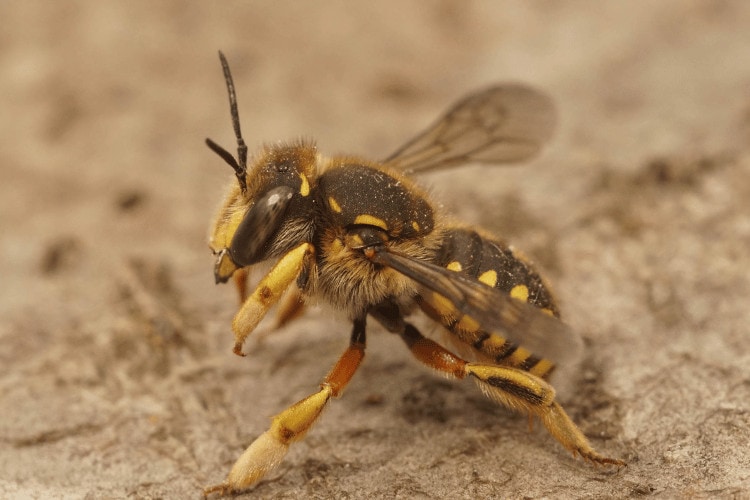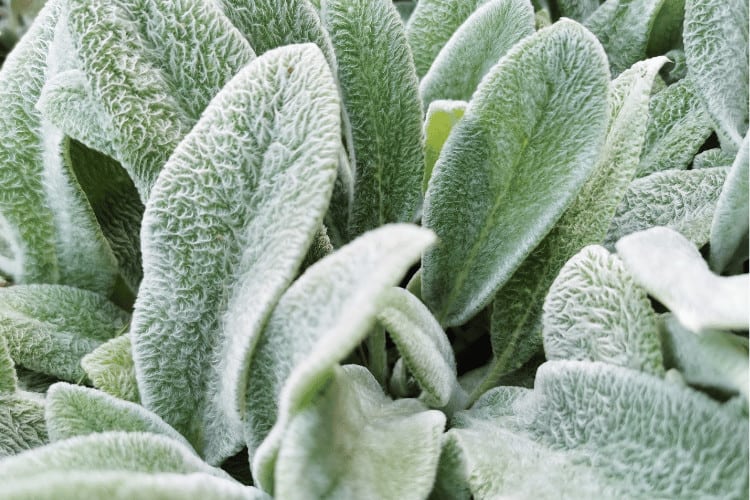A Guide to Wool Carder Bees: Appearance, Personality, and More!
European wool carder bees are fascinating creatures that collect wool-like fibers from plants to build their nests. These iridescent bees exist in multiple places all over the world, including North America and Europe.
While they can be a nuisance when threatened, they’re also important pollinators.
If you’re considering keeping this bee species, you’re in luck!
In today’s guide, I’ll share all the facts I know about these bees, from their looks, habitat, and behavior, to whether or not they’re risky to keep.
Whether you’re ready to start a pollination service, a mere hobby of beekeeping, or another purpose, my article should help you find your way with wool carder bees.
Without further ado, let’s dive in!
Physical Description and Personality Characteristics of Wool Carder Bees

As an aspiring beekeeper interested in wool carder bees (Anthidium maculosum), you’re in for a treat. These bees are one-of-a-kind, whether you’re talking about their remarkable looks or unique characters.
Physical Appearance
Wool carder bees are medium-sized bees, ranging from about 11 to 17 mm in length. Due to their large body size, they’re often compared to honeybees in dimensions.
They’re quite easy to identify by their black bodies with bright yellow or orange markings. The males have long, feathery antennae, while the females have shorter, clubbed antennae and a retractable stinger.
These bees are usually covered with yellow-gray hairs.
One of the most distinctive features of European wool carder bees is their pollen baskets. These baskets are located on their abdomens, and they’re made of hairs that the bees use to comb the pollen from flowers.
Character and Temperament
Wool carder bees are known for their aggressive behavior. They’re not as docile as other types of bees, and they’re more likely to sting if they feel threatened. However, I found out that they’re still not as aggressive as yellow jackets, for example.
These bees are also famous for their intelligence. They can learn and remember where to find food and nesting materials. More interestingly, they excel at building complex nests, which I had the pleasure to witness and gape at firsthand!
What Is the Purpose of Keeping Wool Carder Bees?
As a years-long beekeeper, I’ve learned that there are many reasons to keep wool carder bees, such as:
- Pollination: Wool carder bees are beneficial pollinators, and they can help to increase the yields of fruits, vegetables, and other crops if you’re growing some in your yard. Better yet, they can be ideal if you want to start a pollination service.
- Beauty: These bees are beautiful creatures, and they can add a touch of nature to your garden if you’re not ready to start a beekeeping business yet.
- Low maintenance: This bee species is relatively low-maintenance, so it can be a good choice for beginner beekeepers to test the waters before commitment.
- Uniqueness: Wool carder bees aren’t as common as other types of bees. As a result, they can add a touch of magic to your beekeeping hobby!
Wool Carder Bee Habitat and Foraging Preferences
Wool carder bees are spread over a variety of habitats, including meadows, woodlands, and gardens. They prefer floral territories rich with clover, dandelions, lamb’s ear (Stachys byzantina), and mint.
The flowers that wool carder bees like are those that produce a lot of pollen and nectar. They’re particularly fond of flowers with fuzzy petals, as these provide them with a good source of wool for their nests.
Wool carder bees are active foragers, too. They can travel long distances searching for food and wool fiber to line their nests. In most cases, females will forage for these nest-lining materials, while the males’ job is to protect them during the process.
Where Can You Find Wool Carder Bees?

These bees are most common in areas with mild climates and abundant flowers.
In North America, wool carder bees live in most of the United States, southern Canada, and Mexico. They’re also found in Europe, Asia, and Africa.
Besides North America, wool carder bees are often seen in South America, New Zealand, and the Canary Islands. They’re not a native species, though. That’s why, in New Zealand, they’re less likely to visit native plants.
This may be because native plants don’t produce as much pollen and nectar as non-native plants or because these bees aren’t as familiar with native plants.
Regardless of the reason, the decline in the visitation of native plants by wool carder bees is a concern for conservationists. Native plants are essential for the ecosystem, and they rely on pollination by bees and other insects.
Wool Carder Bees Life Cycle, Mating, and Nesting
Wool carder bees have a unique life cycle and mating behavior that’s fascinating to observe as a beekeeper.
For starters, you should know that they’re solitary bees. In other words, each female wool carder bee builds her nest and takes care of her brood. There’s no such thing as living in a colony with worker bees.
As you know, this isn’t the case with bumblebees or honey bees.
The life cycle begins in the spring when the female bee gets out of her nest. At this point, she’s immediately ready to mate. The males are also active at this time, and they’ll search for females to mate with.
You’d be surprised to know that male wool carder bees are highly territorial!
They’ll stake out a patch of flowers that they think will be attractive to females and defend it against other males. They’re so aggressive that they might even bump into humans who enter their mating space!
The females aren’t as aggressive, but they will sometimes allow larger males to mate with them to gain access to resources essential for their survival.
This is called “convenience polyandry,” and it allows the females to get the best of both worlds. They get to mate with a strong male as well as eat the pollen and nectar from the flowers.
The mating process itself takes about 30 seconds. Afterward, the female will fly off and start building her nest using plant hairs. She will typically choose a cavity in a tree or a hollow plant, or she may use a pre-made nest box.
Importance of Wool Carder Bees in Ecosystems and Agriculture
Wool carder bees are important pollinators because they play a vital role in ecosystems and agriculture.
They help pollinate a variety of garden flowers, including clover, dandelions, and mint. This pollination is essential for the production of different types of crops.
These bees are also essential for the health of ecosystems. They disperse seeds and pollen, not to mention that they provide food for other insects and animals.
Common Questions About Wool Carder Bees
Do you have more questions on your mind about these attractive bees? Let me answer a few right below!
What do wool carder bees eat?
Wool carder bees eat pollen and nectar.
They collect pollen from flowers and use it to provision their nests. This way, it provides the larvae with protein, which they need to grow and develop.
On the other hand, the nectar gives some much-needed energy to the larvae.
Are wool carder bees dangerous?
Generally, wool carder bees aren’t dangerous.
Because they don’t live in colonies like honeybees, they’re slightly less aggressive. They don’t have to protect their young from other bees.
Still, you should be careful when getting close to male bees in the mating season. As I previously pointed out, they exhibit very territorial behavior during this period.
Yet, you can rest assured that their stings aren’t as serious as those of other bees, such as honeybees or yellowjackets.
How to attract wool carder bees?
Wool carder bees are attracted to flowers that produce a lot of pollen and nectar. They’re also drawn to the hairy stems or fuzzy leaves of plants. Some of the blooms and common plants they like include:

- Clover
- Dandelions
- Mint
- Lamb’s ear (Stachys byzantina)
- Purple coneflower
- Goldenrod
- Sunflowers
- Achillea millefolium (yarrow)
- Borage
- Catnip
- Echinacea
- Foxglove
- Lavender
You can also invite wool carder bees over by providing a source of nesting material, such as wool or hair.
What are some other common names for wool carder bees?
Wool carder bees are also known by a variety of other common names, including:
- Wool-carder bee
- Wool-gather bee
- Wool-gatherer bee
- Woolly bee
- Felt bee
- Carder bee
- Leaf-cutter bee
- European wool carder bee
- Mason bee
To Conclude
Wool carder bees are lovely creatures that play an important role in the ecosystem.
They’re mainly attracted to flowers that produce a lot of pollen and nectar. Yet, most importantly, they hover around blooms with fuzzy petals to collect wool for building intricate nests for their younglings.
These bees call a variety of habitats home, and these include gardens, meadows, and forests.
While they might be low-maintenance and relatively easy to keep, you may need to be extra careful around European wool carder bees if you’re a beginner. That’s because they have aggressive tendencies, which will require a more seasoned beekeeper.
Trust me; I’ve learned this the hard way!
